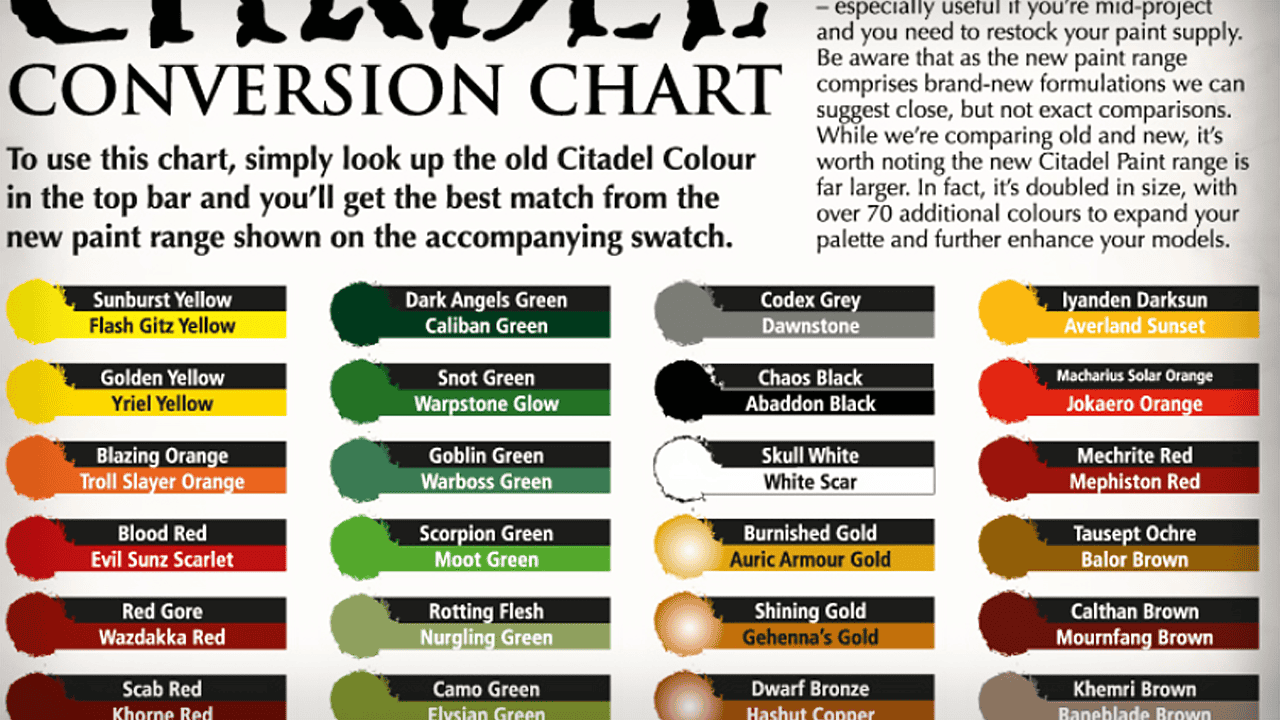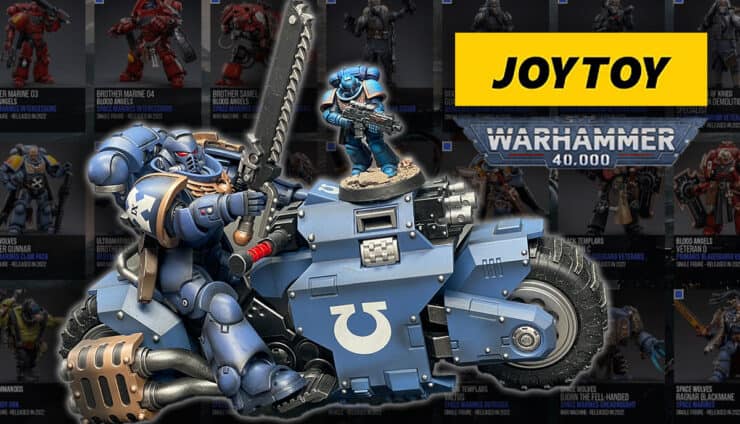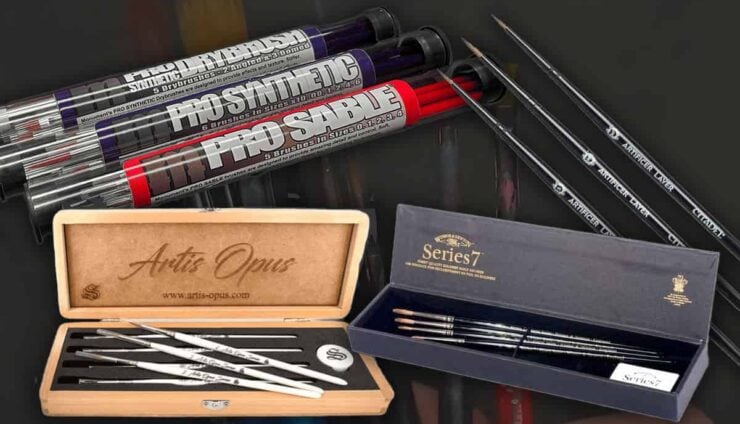Match your Citadel Paints with these free color conversion chart PDFs for flawless layering, organizing, and painting your Games Workshop Warhammer miniatures!
Updated May 19th, 2025, by Rob Baer with new information and links to relevant content.
Warhammer miniatures are the ultimate blank canvas for painters who want to bring their armies to life. But before you can make your Space Marines gleam (and honor the new codex) or your Orks ooze grime and chaos, you’ll need to get acquainted with the Citadel Paint Chart.
These trusty guides serve as the holy book of miniature painting, a roadmap to navigating the Citadel’s labyrinth of colors.
Convert Old Citadel Colors to New
If you’ve been in the Warhammer hobby for a while, you’ve probably experienced the chaos of Citadel’s paint range changes over the years. One minute, you’re hoarding pots of your favorite Blood Red, and the next, it’s been discontinued and replaced with Evil Sunz Scarlet.
Fortunately, there is a paint chart for Citadel and a color conversion system that helps you navigate these changes, and we’ve got just the thing to keep your paint rack organized.
Free PDF Download of the Citadel Paint Color Chart
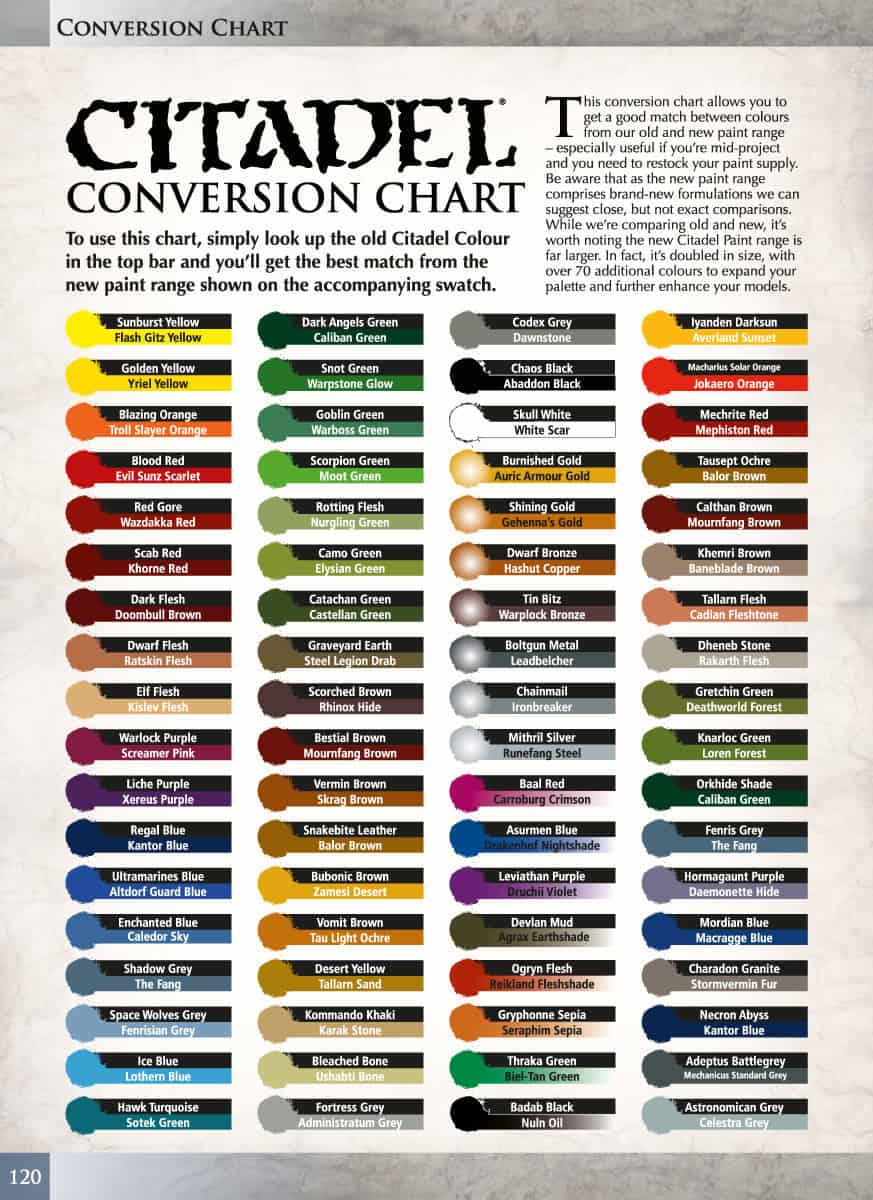
This handy reference is a must for hobbyists who find themselves digging through a pile of old Citadel paints or want to maintain consistency in their army’s look. The days of guessing whether your Space Marine was originally painted with Regal Blue or Kantor Blue are over.
Now, you can convert your beloved old paints to their newer equivalents and keep your army cohesive. Plus, let’s be honest; it feels pretty great not to spend hours on the internet hunting for paint conversion answers!
Tips for Perfect Color Matching & Organization
Whether you’re new to Warhammer or you’ve been converting your spare bedroom into a hobbyist’s bunker for years, this chart is key to getting the most out of your paints.
And hey, Citadel didn’t make things easy over the years, with their old paint names evolving into new, more dramatic titles. A quick paint conversion chart is essential if you’re ever confused about whether you’re supposed to be using Mephiston Red or some elusive blood-red cousin from 2009.
So, let’s break down this chart and get you ready to paint miniatures like the true commander of the battlefield you are. If you want to see the conversion charts for companies like the Army Painter, check that out here.
Latest Citadel Color Paint Chart
Citadel has come a long way since the days of Goblin Green bases, and your collection of paints probably spans multiple generations of their range. Luckily, there’s a clear path to finding the modern equivalent of the colors and how to choose yours!
This Citadel Color Chart PDF will have your answers, and it is up on Games Workshop’s site, or you can grab it here.
Red Paints

Fear not; this new shade brings the same intensity, perfect for making your minis stand out on the battlefield.
Blue Paints
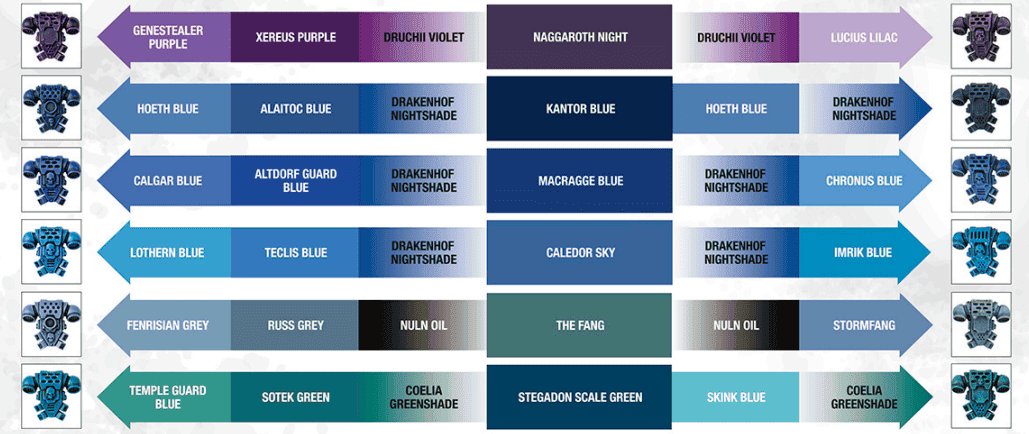
Don’t forget about the other blue shades in the range. For example, Regal Blue, a classic dark blue often seen on Imperial armor, has now morphed into Kantor Blue. Whether you’re painting Imperial Navy or a grimdark knight, Kantor’s got your back.
Citadel Color Chart: Green Paints
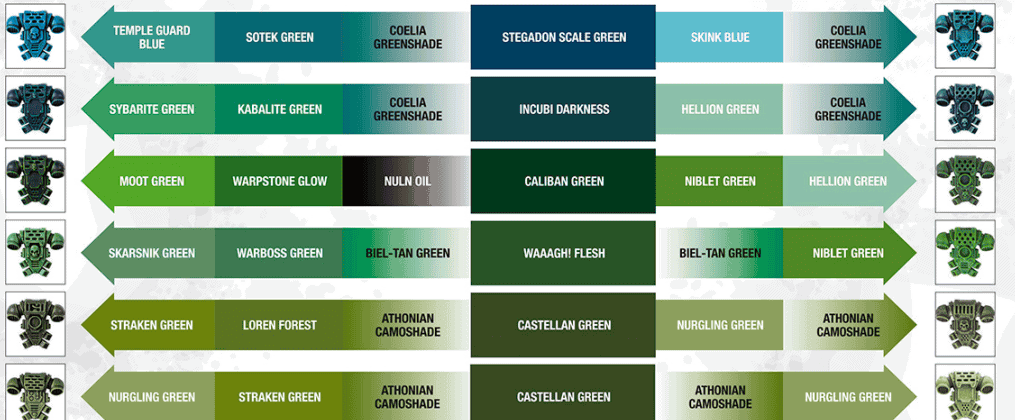
Meanwhile, Camo Green has been replaced by Elysian Green, and Snot Green has morphed into Warpstone Glow—a perfect color for anyone who wants to emphasize the manic energy of their Skaven or Greenskins.
Grey and Metallic Paints
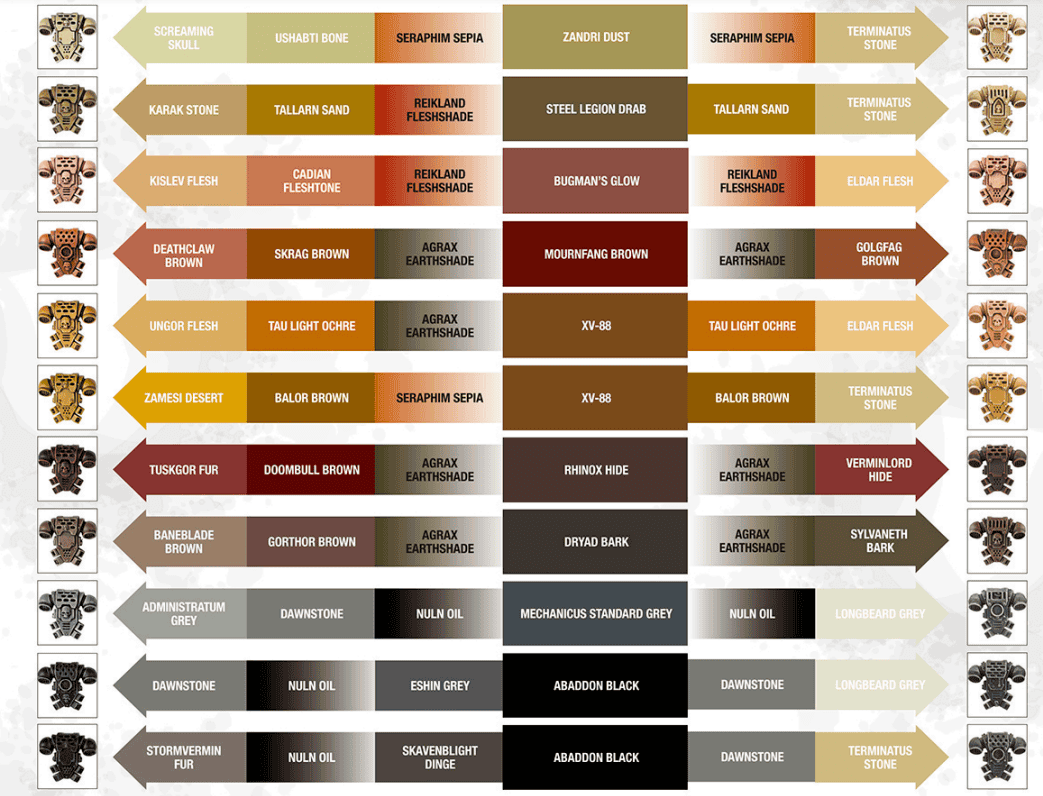
It’s now known as Leadbelcher, a name just as gritty and powerful as its predecessor. This paint is ideal for any project that requires a touch of industrial strength—perfect for those grimy weapons or clunky tank treads.

Tips for Beginners: How to Use the Right Paints
If you’re new to painting Warhammer miniatures, the Citadel Paint Color Chart might look a little like ancient arcane text. But don’t worry—decoding it isn’t as hard as summoning a Daemon. With the right paints and a little patience, you’ll turn that grey plastic into a work of art worthy of the Emperor.
Let’s break down how to pick the best combination of base, layer, and shade paints, so your miniatures can dominate the tabletop both in battle and style.
How to Choose Base, Layer, and Shade Combinations

Let’s say you’re painting an Ultramarine. Your first step is to grab Macragge Blue as your base coat. This iconic color is perfect for that rich, loyalist blue. Once it’s on and dry, it’s time to add some depth.
Reach for Altdorf Guard Blue, a layer paint designed to highlight the armor’s raised surfaces and edges. Just a light touch on the edges will make the blue look more vibrant and natural.
Finally, we need to shade the model to bring out the fine details. Drakenhof Nightshade is perfect here—it flows into the recesses, giving shadows to the armor’s crevices and making those Ultramarine pauldrons look like they’ve weathered the long war. These three paints—Macragge Blue, Altdorf Guard Blue, and Drakenhof Nightshade—work together in harmony to create a striking finish.
Advanced Techniques with Layer and Shade Paints
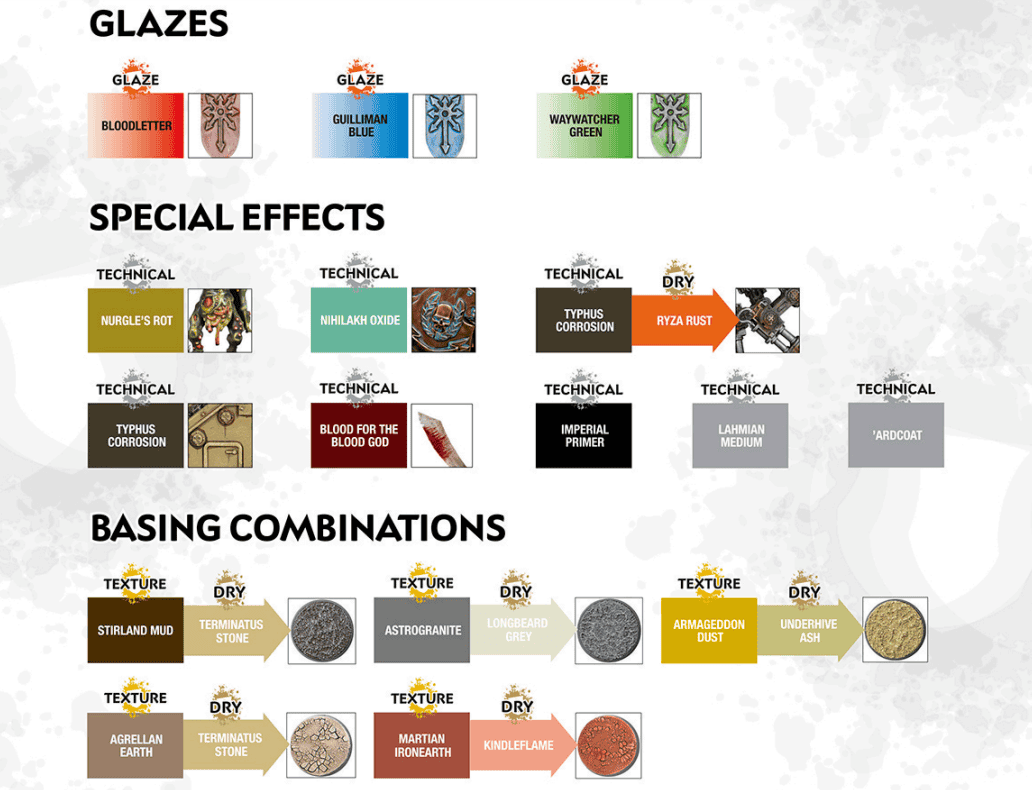
For example, blending Evil Sunz Scarlet with Wild Rider Red on your Blood Angels will give a smooth transition from shadow to light on their armor. The trick here is thinning your paints with water or medium to create a more transparent layer, allowing the colors to gently transition into one another. Patience is key, but the results are worth it.
Don’t forget about shade paints—they’re not just for quick washes. You can use them with more precision, applying Nuln Oil carefully in small recesses or using Seraphim Sepia for weathering effects on parchment or bones. By focusing on individual areas rather than slathering a wash over the entire model, you’ll bring out those intricate details with a more professional touch.
Final Thoughts on the Citadel Paint Charts
So, whether you’re gearing up for your first Warhammer skirmish or you’ve painted enough Space Marines to field an entire chapter, having the right tools makes all the difference.
From perfectly layered Ultramarines to battle-worn Chaos tanks, it’s all about finding the balance between order and chaos, both on the battlefield and on your paint rack.
Remember, painting isn’t just a hobby; it’s an art form worthy of the Emperor’s gaze—or, if you’re on the other side of things, Nurgle’s delight. So grab that brush, crack open that pot (carefully), and bring those miniatures to life like the mighty heroes—or grotesque villains—they are. And if things get messy, hey, that’s what Nurgle would want, right?
The Ultimate Guide To Painting Miniatures
What do you think about the Games Workshop Citadel color and paint conversion charts?
